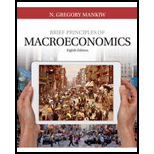
Bundle: Principles of Economics, Loose-leaf Version, 8th + LMS Integrated MindTap Economics, 2 terms (12 months) Printed Access Card
8th Edition
ISBN: 9781337607735
Author: N. Gregory Mankiw
Publisher: Cengage Learning
expand_more
expand_more
format_list_bulleted
Question
Chapter 34, Problem 2PA
(a):
To determine
Liquidity preference theory to explain the impact of the policy.
(b):
To determine
Impact of change in interest rate on output and
(c):
To determine
Change in price due to change the short run equilibrium to long run equilibrium.
(d):
To determine
Impact of change in the price level on
(e):
To determine
Real effect of money
Expert Solution & Answer
Want to see the full answer?
Check out a sample textbook solution
Students have asked these similar questions
Key shortcomings of the Human Capital approach to measuring the monetary value of benefits of new treatments are that it
Will generate lower benefits for male lives on average
Will generate higher benefits for female lives on average
Will tend to OVERVALUE improvements in quality of life
Will tend to UNDERVALUE improved survival for people out of labour force
One of the key concepts in economics that underpins the necessity of making tough choices and confronting difficult tradeoffs through some form of collective decision-making is called
Production
Consumption
Exchange
Equity
Scarcity
Allocative efficiency WITHIN the health care sector refers to
What mix of nonmedical and medical goods and services should be produced in the macro-economy
What mix of medical goods and services should be produced in the health economy
What specific health care resources should be used to produce the chosen medical goods and services
Who should receive the medical goods and services that are produced
Chapter 34 Solutions
Bundle: Principles of Economics, Loose-leaf Version, 8th + LMS Integrated MindTap Economics, 2 terms (12 months) Printed Access Card
Knowledge Booster
Similar questions
- Production efficiency is most concerned with Choice of inputs in production process Quantity of outputs resulting from the production process The technological process of production All of the abovearrow_forwardChoose all of the following that are assumed to be constant while constructing the production possibilities curve Technology Precise mix of inputs Institutional arrangements like judicial protection of business contracts Outputsarrow_forwardA point that lies OUTSIDE of the PPC can be achieved if A major technological innovation increases production efficiency A sudden influx of resources e.g., massive immigration of trained nurses Economic reform resulting in greater protection of intellectual property rights All of the above Only options 1 and 2arrow_forward
- The marginal benefit from each successive unit of medical care consumed declines BECAUSE each successive unit is more expensive to produce True Falsearrow_forwardIn the Human Capital approach, estimated monetary worth of life is MOST SENSITIVE to which key indicator Discount rate Social security payroll taxes Labour market earnings Workplace injury compensationarrow_forwardOver the last few decades out-of-pocket costs have formed a DECLINING proportion of total consumer expenditure on medical care True Falsearrow_forward
- Cost benefit analyses often assumes the following about consumers EXCEPT Consumers have clear preferences among choices they are exposed to Consumers purposely choose actions that result in higher satisfaction Consumers factor in uncertainty of outcomes in their decision-making regarding net benefits and costs Consumers lack information about attributes of market goods that are necessary for ranking their choice setarrow_forwardThe TRUE relationship between MARGINAL utility and an individual’s stock of health can be best described as a scatter plot True Falsearrow_forwardMany health economists believe that the United States spends its MARGINAL dollars on healthcare in a highly wasteful manner. This view is also known as “flat of the curve” medicine. True Falsearrow_forward
- Increasing provision of out-of-pocket cost calculators by major insurers are attempts to REDUCE price transparency for consumers True Falsearrow_forwardA price hike for medical goods/services that have an inelastic (i.e., <1) own-price elasticity of demand will tend to yield lower revenues True Falsearrow_forwardRisk Loving people are willing to pay insurance premiums that exceed their expected losses True Falsearrow_forward
arrow_back_ios
SEE MORE QUESTIONS
arrow_forward_ios
Recommended textbooks for you
 Essentials of Economics (MindTap Course List)EconomicsISBN:9781337091992Author:N. Gregory MankiwPublisher:Cengage Learning
Essentials of Economics (MindTap Course List)EconomicsISBN:9781337091992Author:N. Gregory MankiwPublisher:Cengage Learning Brief Principles of Macroeconomics (MindTap Cours...EconomicsISBN:9781337091985Author:N. Gregory MankiwPublisher:Cengage Learning
Brief Principles of Macroeconomics (MindTap Cours...EconomicsISBN:9781337091985Author:N. Gregory MankiwPublisher:Cengage Learning Principles of Economics (MindTap Course List)EconomicsISBN:9781305585126Author:N. Gregory MankiwPublisher:Cengage Learning
Principles of Economics (MindTap Course List)EconomicsISBN:9781305585126Author:N. Gregory MankiwPublisher:Cengage Learning Principles of Macroeconomics (MindTap Course List)EconomicsISBN:9781285165912Author:N. Gregory MankiwPublisher:Cengage Learning
Principles of Macroeconomics (MindTap Course List)EconomicsISBN:9781285165912Author:N. Gregory MankiwPublisher:Cengage Learning Principles of Economics, 7th Edition (MindTap Cou...EconomicsISBN:9781285165875Author:N. Gregory MankiwPublisher:Cengage Learning
Principles of Economics, 7th Edition (MindTap Cou...EconomicsISBN:9781285165875Author:N. Gregory MankiwPublisher:Cengage Learning Principles of Macroeconomics (MindTap Course List)EconomicsISBN:9781305971509Author:N. Gregory MankiwPublisher:Cengage Learning
Principles of Macroeconomics (MindTap Course List)EconomicsISBN:9781305971509Author:N. Gregory MankiwPublisher:Cengage Learning

Essentials of Economics (MindTap Course List)
Economics
ISBN:9781337091992
Author:N. Gregory Mankiw
Publisher:Cengage Learning

Brief Principles of Macroeconomics (MindTap Cours...
Economics
ISBN:9781337091985
Author:N. Gregory Mankiw
Publisher:Cengage Learning

Principles of Economics (MindTap Course List)
Economics
ISBN:9781305585126
Author:N. Gregory Mankiw
Publisher:Cengage Learning

Principles of Macroeconomics (MindTap Course List)
Economics
ISBN:9781285165912
Author:N. Gregory Mankiw
Publisher:Cengage Learning

Principles of Economics, 7th Edition (MindTap Cou...
Economics
ISBN:9781285165875
Author:N. Gregory Mankiw
Publisher:Cengage Learning

Principles of Macroeconomics (MindTap Course List)
Economics
ISBN:9781305971509
Author:N. Gregory Mankiw
Publisher:Cengage Learning